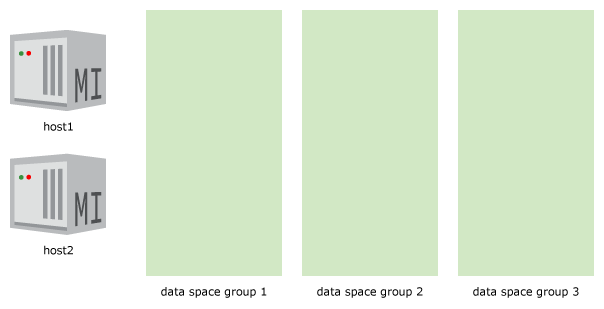Adding the Standby Management Instance
TimesTen Scaleout automatically configures the second management instance as the standby. All operations that use and manipulate the configuration of the grid must be performed from the active management instance with the ttGridAdmin utility.
It is highly recommended that every management instance that you configure in a grid is located on a different host. Those hosts should be in different failure domains (with independent power, storage, and other resources). You must manually add every host to the model by providing the communication parameters (fully qualified domain or IP address) of the system they are associated with.
The ttGridAdmin hostCreate command defines a host object in the model. This command enables you to create an instance (management or data) and copy the attributes, such as the data space group, of an existing host by using the -like option. In addition, you have the option to copy the associated installations and instances by using the -cascade option along with the -like option.
Create a standby management instance and its associated installation by duplicating the host associated with the active management instance, host1.instance1. Ensure that you identify the fully qualified domain name or IP address of the new host.
% ttGridAdmin hostCreate -internalAddress int-host2 -externalAddress ext-host2.example.com -like host1 -cascade
Host host2 created in Model
Installation installation1 created in Model
Instance instance1 created in ModelNote:
-
If you do not specify a name for the host, TimesTen Scaleout sets the OS hostname of the remote system as the name of the new host.
-
Any additional options you define in the
ttGridAdmin hostCreatecommand will overwrite the attributes inherited from the existing host in the new host. In this example, TimesTen Scaleout uses the same values for the daemon, server, and management ports (6624,6625, and3754, respectively) as the values set for thehost1.instance1management instance. -
This example uses the
-likeand-cascadeoptions of thettGridAdmin hostCreatecommand to create the standby management instance and its associated host and installation. Alternatively, you can create them separately. See Adding Data Instances.
Figure 4-3 shows a graphical representation of the model of the grid1 grid after creating the host2 host, host2.installation1 installation and host2.instance1 management instance.
Figure 4-3 The Model After Creating the Standby Management Instance

Description of "Figure 4-3 The Model After Creating the Standby Management Instance"
Notice that the names assigned to the installation and management instance created
for the host2 host are identical to the names assigned to the
host1 host, a result of the cascade operation. This does not
generate a conflict, since the fully qualified names are different. See Grid Objects
and Object Naming in Oracle TimesTen In-Memory Database
Reference.
For more information on the ttGridAdmin hostCreate command, see
Create a
Host (hostCreate) in Oracle TimesTen In-Memory Database
Reference.